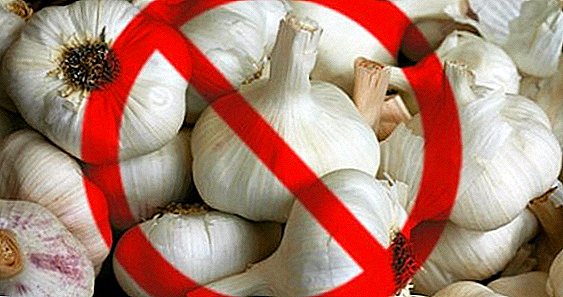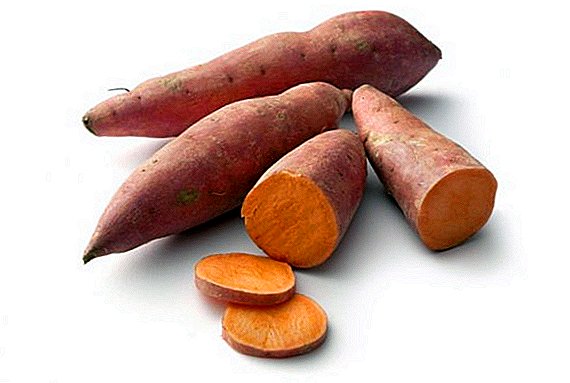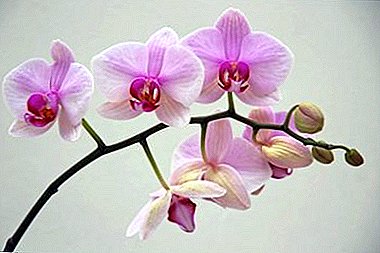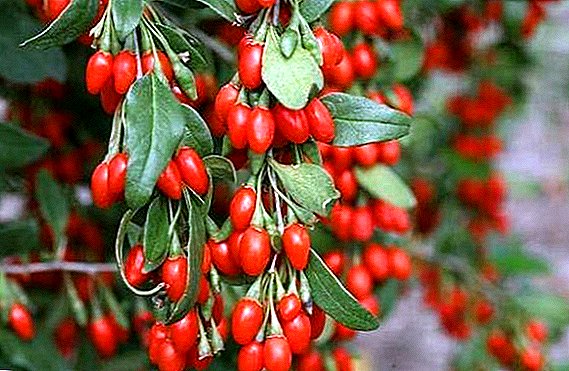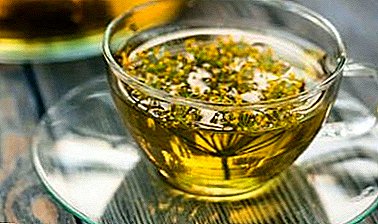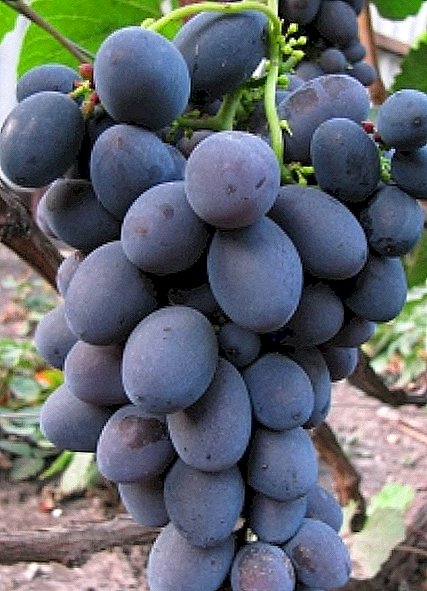
To date, grow a grapevine is not difficult.
Whatever the variety, with proper care it will bear fruit and please the eye of the gardener.
Vineyards are not only beautiful structures in their structure, but also useful in terms of harvest.
You can also replenish your collection of grapes with "Gala" grapes.
Description of the grape variety "Gala"

The variety "Gala" is a bright representative of table grapes, which was obtained by crossing the varieties "Gift to Zaporozhye" and "Kodryanka" by V.V. Zagorulko.
Ripens quicklyfor 110 - 125 days. Bushes are vigorous, the leaves are large, shoots ripen well. Flowers bisexual. The clusters are large, the mass reaches 1 kg, sometimes there are 2 kg, of cynical or cylindrical shape. The berries are large, oval-shaped, blue, led to 12 g. The flesh is juicy, fleshy, with a sweet-sour taste.
"Gala" gives abundant, stable yieldtherefore, you should monitor the load on the vines. Otherwise, the taste and size of the berries will change, which is not good. The frost resistance is average, can withstand a minimum temperature of -21 ° C.
There is a fairly good resistance to mildew and oidium. When overripe, wasps can damage the crop, so clusters should be removed on time. If there is an excess of moisture in the soil, the "Gala" berries can crack.
Virtues:
- yield stability
- good taste
- resistance to fungal diseases
disadvantages:
- average frost resistance
- the berries crack with an excess of water
About the features of planting varieties

Since the variety "Gala" has average frost resistance, it is better to plant these grapes in spring, when frosts are no longer foreseen.
When buying, you need to carefully examine the sapling so that there are no mechanical damages and consequences from illnesses.
Before planting, the root system of the seedling needs to be prepared, that is, cut off the roots. Thus, the roots are refreshed. In addition, you need to shorten and escape, and if they are two or more, then the weaker cut off. On the shoot should remain 2 - 3 peepholes.
For planting grapes digging holes 80x80x80 cm at a distance of 2 - 3 meters from each other. At the bottom of the pit, a layer of 30-40 cm thick fertile land is filled with organic fertilizers (2-3 buckets per pit) and superphosphate.
A sapling is put on this layer with a "heel", which should be poured on 5-10 cm with the same mixture of soil. Further, the pit is filled with ordinary soil without additional fertilizers, but it is not fully filled.
It is necessary to leave 5 - 10 cm of empty space for future watering. A small fossa with a diameter of 30 cm is formed around the shoot into which, after planting, it is necessary to pour water and fill the mulch.
Tips for caring for a variety of "Gala"
- Watering
Gala berries can suffer from excess moisture, so you need to be careful when watering. Grapes need moisture throughout the growing season, that is, from April to October.
The first watering is done in early spring, when frost is not foreseen.
After the successful pruning was done (the cuts did not begin to “cry”), you need to water it a second time.
Next, the bushes "Gala" need water if necessaryso that there is no excess moisture.
You can not water the grapes during flowering, otherwise the flowers will crumble.
After you have already removed the clusters from the branches, you need to replenish the supply of moisture for the winter.
The last watering is called water recharge and is calculated as 50 - 70 liters of water per 1 square meter. At all other times, the volume of watering should be 40 - 60 liters per 1 sq. M.
To properly water the grapes, you can install a drainage system or dig a few holes 30–40 cm deep around the bush. These pits should be about 50 cm from the trunk.
- Mulching
Mulching plays a very wet role in maintaining the water balance of the soil. After landing, be sure to mulch the seedling around the seedlingso that young roots do not experience a lack of moisture.
Mulch the land should be regularly throughout the growing season. Before covering saplings or bushes, the soil also needs to be mulched. Peat, humus, straw, leaves, and also special materials can be used as a necessary material.
The layer thickness of organic mulch should be about 5 - 10 cm.
- Harboring

To protect the bushes from frost and cold winter wind, they must be covered for the winter.
Before the shelter is required water recharge irrigation!
To cover the bushes, they need to be tied up, laid on the material that has been laid on the ground in advance and secured. After that, special iron arches are installed above the bushes, which need to be well submerged into the ground. On these arches polyethylene or other protective material is stretched, on the side it should be fixed on the ground.
The ends must first be left open before the onset of cold, and then opened already during the thaw. In addition to this method, there is another common. The essence of this method is the dusting of folded bushes with a large amount of earth, and later - with snow. If you do everything right, then your grapes will not be afraid of cold.
- Pruning
Pruning grapes plays a very important role in shaping the future harvest and its quantity. After all, if the load on the bush is too large, then the berries of “Gala” will lose their exquisite taste and decrease in size. Therefore, in the fall, shortly before the shelter, you should cut the vines, leaving 6 - 8 eyes.
The total number of buds on one bush should be no more than 45.
- Fertilizer
Shrubs “Gala” will respond well to fertilization, therefore, regular and proper feeding should not be forgotten. Young seedling no fertilizer needed. But in subsequent years it is recommended to feed at least three times during the season.
You need to make both organic and mineral fertilizers. Humus, compost and similar top dressing is applied once every 2 - 3 years with the calculation of 10 kg per 1 sq. M. Mineral fertilizers are applied annually.
In early spring, you need to make nitrogen, for example, ammonium nitrate. And before and after flowering you need to make superphosphate and potassium salts. As a result, you get a bountiful harvest.
- Protection

Despite the resistance of the Gala bushes to mildew and oidium, preventive measures will not interfere. After all, if any foreign blot appeared on the leaves, then you need to take urgent measures.
The likelihood of such spots on the leaves of "Gala" is small, but you can treat the bushes before flowering with fungicides or 1% Bordeaux mixture. This will precisely protect your bushes from the effects of various fungal diseases.



